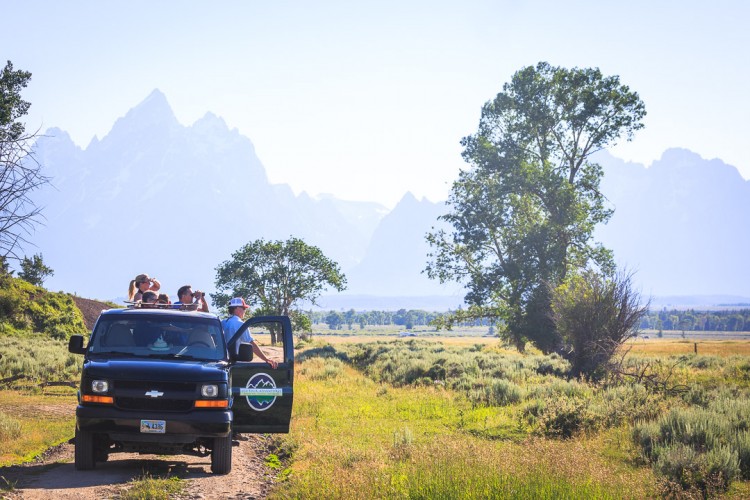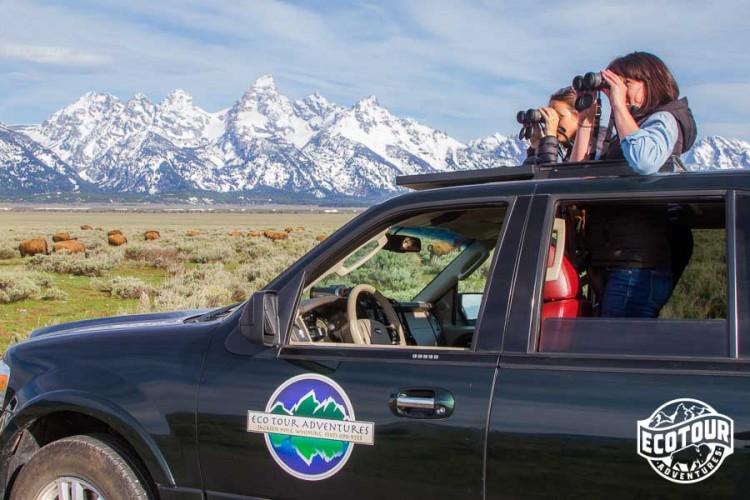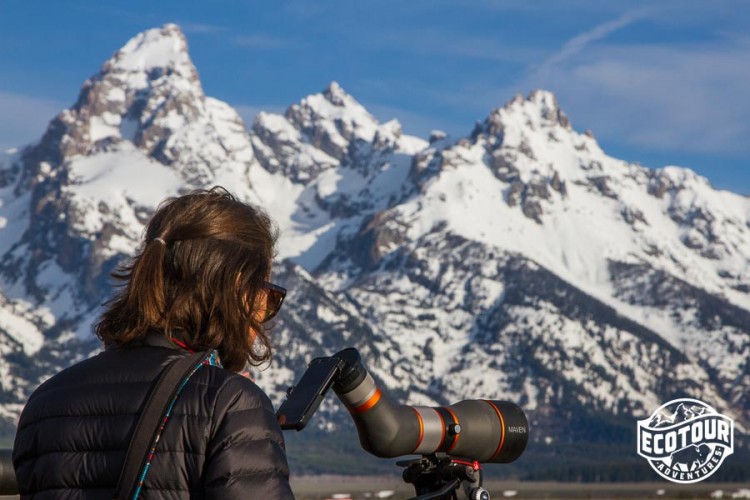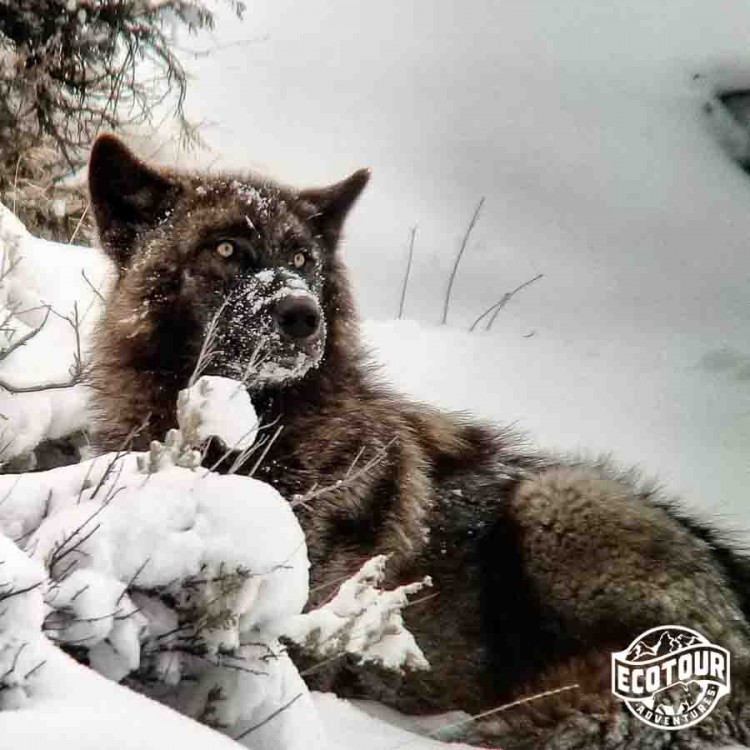Secrets to Successful Wildlife Watching in Grand Teton and Yellowstone Part 2: Tools of the Trade, Safety and Ethics


In Part One of our “Secrets to Successful Wildlife Watching in Grand Teton and Yellowstone” blog we outlined Wildlife Watching Through the Seasons. Now let’s look at what you need to have the best experience possible.
Tools of the Trade
Optics - At 2.5 million acres, Grand Teton and Yellowstone occupy a vast landscape, and optics are critical for spotting and watching wildlife. We use Lander, WY based Maven Optics for both binoculars and spotting scopes.
8x42 C.1 binoculars are a good bet for all purpose wildlife and bird watching. The first number, 8 means a magnification of 8x, while the second number, 42 is the diameter of the binocular glass. A bigger diameter means more light transmission and a clearer image. I personally use the 9x45 B.2 to get a bit more magnification, but have to deal with a heavier binocular as a trade off. With up to 50x magnification, the S.1 Spotting Scope is our go to for viewing wildlife such as wolves and grizzlies from afar. Both binoculars and spotting scopes are also useful for viewing small animals like birds up close. The color and plumage of birds up close is surprisingly stunning, just one reason why bird watching is so popular across the globe.

Binoculars and our Roof Hatches allow for safe viewing, especially when wildlife are close to the vehicle!
Camera - Professional and amateur photographers alike flock to Yellowstone and Grand Teton especially during the spring and fall, sporting giant expensive lenses and tripods. This option may be available to some, but there are some less expensive camera/lens options. I recommend a telephoto lens around 100-400mm for wildlife photography, and a wider angle lens like a 24-105mm for landscapes.
PhoneSkope Adaptor - The evolution of camera phones has recently created some great opportunities when combined with spotting scopes or binoculars for digiscoping - taking pictures through optics. We use Phoneskope phone adaptors and rings to attach phones to our spotting scopes on tours, and our guests leave with great photo and video from the trip!

PhoneSkope Adaptors allow us to take clear video and photos through our Maven S.1 Spotting Scopes.

Guide Verlin Carlton captured a photo of this black wolf using his cell phone and phoneskope adaptor while on tour in Grand Teton National Park!
Local Knowledge - When a few of the EcoTour Adventures Team visited South Africa’s Kruger National Park for a week of wildlife watching, we hired a local guide who could show us where the wildlife hotspots were. Being able to sit back and enjoy the sights while someone else drove, shared information about what we were seeing, and had a good spotters eye was worth every penny. That’s why your best Tool of the Trade is the local knowledge of an experienced guide. Guides familiar with the area know wildlife habits, increasing your chances of that once in a lifetime sighting while facilitating a deep connection to place.
Safety and Ethics of Wildlife Watching
With all the excitement around Yellowstone and Grand Teton National Parks, visitors and locals alike need to be aware of how to safely and ethically view wildlife. NPS guidelines state that wildlife must be viewed from 25 yards or more, 100 yards if it is a bear or wolf. If we visibly change the animals behavior we are too close. Millions of visitors visit the parks annually hoping for views of wildlife, so it’s important to give wildlife space, they likely interact with people frequently!
Bear Safety
A common concern among visitors to Yellowstone is bears. Though grizzlies in particular can be dangerous, only 8 people have been killed since the founding of the park in 1872! We always recommend carrying bear spray, traveling in groups and making noise when traveling away from vehicles.
Bear spray needs to be carried for immediate access, you can’t ask a bear or charging moose to wait while you fumble around for it in your backpack. If you encounter a bear make noise and slowly back away. If it charges within 30 feet spray your can towards the bear at a downward angle so it hits the ground and creates a cloud which the bear will run through. It’s over 90% effective, and doesn’t kill the bear either. Be aware that cans can explode in a hot vehicle or if dropped and punctured. As someone who has been sprayed before I can attest it’s extremely unpleasant. It won’t kill you but you will remember the burning sensation.
Stewarding Wildlife of the Greater Yellowstone Ecosystem for the Future
It’s clear that more and more nature starved urbanites crave the wildness of places like the Greater Yellowstone Ecosystem. Though the massive bison herds who once roamed the Great Plains remain ghosts, they persist in the Hayden and Lamar Valleys. Wolves, grizzlies, and mountain lions still hunt here, sustained by the epic migrations of over 10,000 elk in and out of the park’s each year. Today, thanks to over a century of dedicated conservation work the Greater Yellowstone Ecosystem has a richer biological diversity and abundance of wildlife than any time in the last 130 years. Yellowstone and Grand Teton National Parks offer a snapshot into our wild past, so what are you waiting for, come see it for yourself!
Josh Metten is a Senior Naturalist and Photographer for Jackson Hole EcoTour Adventures
Join us on an adventure in Grand Teton or Yellowstone National Park by calling us 307-690-9533 or emailing info@jhecotouradventures.com.
Now in our 11th year of operation, Jackson Hole Ecotour Adventures leads wildlife safaris, cross country skiing tours, and snowshoe tours in Grand Teton and Yellowstone National Parks 365 days a year. Let us help maximize your Jackson Hole Experience Today!













